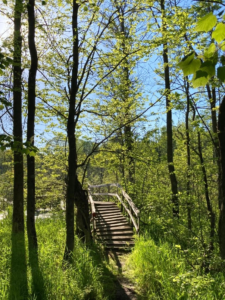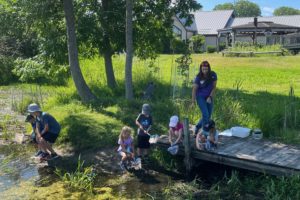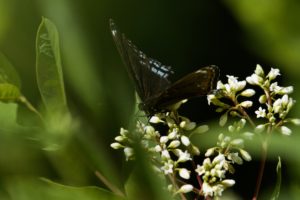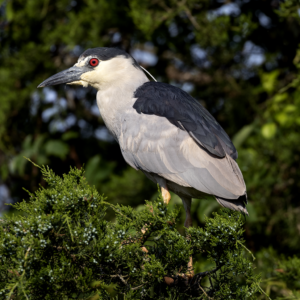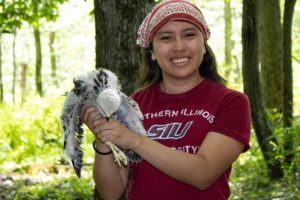 by Julia Beckner, summer intern
by Julia Beckner, summer intern
Upon arriving at Woodland Dunes, I did not ever think I would be excited about anything bird related. I have never really been much of a bird person and was a bit burned out on the subject after just completing an ornithology class this past semester. However, one morning us interns were in for a very interesting experience. We were meeting with a researcher to band a Red-shouldered hawk. I was not quite sure what I was expecting to happen at first. In my mind, I thought we were going to be banding adult hawks, which made me a bit nervous since they have rather strong talons. It was a nice surprise to find out that it was really a baby we were going to watch get banded.
Once we arrived at the trail, we met with the researcher and his climber who would be getting the baby and information about the nest for us. The researcher explained to us that he was one of the few who studied Red-shouldered hawks since they were not as easily accessible as Red-tailed hawks. Red-tailed hawks are much more likely to have nests on edge areas, so sometimes this means along highways or trails. They also do not have as large of a territory as Red-shouldered hawks usually do. Red-shouldered hawks like a lot of forest area when they nest. This has led them to be more threatened than Red-tailed hawks, due to deforestation making areas too small for them to occupy.
Once we arrived, the researcher explained the process of what was going to happen as he and the climber both got set up. The adult hawks soared above us through the whole experience. Once both were ready, the climber made his ascent.
I once again found myself unsure and curious as to how he was going to bring the baby down. It was somewhat comical; the baby was sent down in a backpack. The researcher talked us through everything he did: body measurements, how he estimates age, and why feathers are taken. Some of us got to do small tasks to assist throughout the whole process. Measuring the weight was rather entertaining since the baby was essentially put into a sock with its feet still sticking out. At the end of everything, each intern and staff that had come along got a chance to hold the baby before it was sent back up to the nest.
I may still not be a bird person, but I definitely loved the experience and would join again if given the chance.
photo by Sue Crowley

